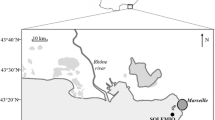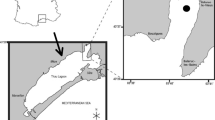Abstract
Bacterial activity was measured in the river Seine by two methods, 3H-thymidine incorporation into DNA and 3H-leucine incorporation into proteins. Both incorporation rates are characterized by low values upstream of Paris, a large increase just downstream of the outfall of the Achères treatment plant effluents, and then decreasing values further downstream. The covariation of both activities is demonstrated by the constancy of the molar ratio (leucine to thymidine incorporation rate) in the range of 6 to 8 for all the samples, except in the perturbed area where it is higher (15 to 35). These high values of molar ratio are linked to the introduction into the river of large sized bacteria (⩾1 µm) with higher incorporation rates per cell or biomass unit than the small autochthonous bacteria (< 1 µm). Growth rates of large bacteria were on average 3.7 times higher than those of small bacteria. Bacterial production was calculated with experimentally determined conversion factors (0.5 × 1018 cells per mole of thymidine incorporated and 900 gC per mole of leucine incorporated) and by taking into account the activity of both size classes of bacteria measured through fractionation experiments (post-incubation filtration). Production estimated in the perturbed area downstream of Ach6res was very high, up to 60 µgC liter−1h−1 in the summer. Carbon consumption by bacteria in the area perturbed by the Ach6res effluents was calculated assuming a growth yield of 0.2 and compared to the load of biodegradable organic matter discharged by the treatment plant. In summer, an additional supply of organic matter is required to account for the intense bacterial activity, suggesting the importance of phytoplankton production in the carbon budget.
Similar content being viewed by others
References
Azam F, Fuhrman JA (1984) Measurement of bacterioplankton growth in the sea and its regulation by environmental conditions. In: Hobbie JE, Williams PJLeB (eds) Heterotrophic activity in the sea. Plenum Press, New York, pp 179–196
Bell RT (1988) Thymidine incorporation and estimates of bacterioplankton production: Are the conversion factors valid? Arch Hydrobiol Beih Ergebn Limnol 31:163–171
Billen G, Servais P, Fontigny A (1988) Growth and mortality in bacterial population dynamics of auaatic ecosystems. Arch Hydrobiol Beih Ergebn Limnol 31:173–183
Billen G, Servais P, Becquevort S (1990) Dynamics of bacterioplankton in oligotrophic and eutrophic aquatic environments: Bottom-up or top-down control? Hydrobiologia 207:37–42
Bjornsen PK, Kuparinen J (1991) Determination of bacterioplankton biomass, net production, and growth efficiency in the Southern Ocean. Mar Ecol Prog Ser 71:185–194
Chesterikoff A, Garban B, Ollivon D (1991) Daily rhythms in the river Seine. Relative impacts of natural and anthropic factors. Wat Res 25:1523–1528
Chin-Leo G, Benner R (1991) Dynamics of bacterioplankton abundance and production in seagrass communities of a hypersaline lagoon. Mar Ecol Prog Ser 73:219–230
Chin-Leo G, Kirchman DL (1988) Estimating bacterial production in marine waters from the simultaneous incorporation of thymidine and leucine. Appl Environ Microbiol 54:1934–1939
Cole JJ, Findlay S, Pace ML (1988) Bacterial production in fresh and salwater ecosystems: A cross system overview. Mar Ecol Prog Ser 43:1–10
Fuhrman JA, Azam F (1980) Bacterioplankton secondary production estimates for coastal waters of British Columbia, Antartica, and California. Appl Environ Microbiol 39:1085–1095
Fuhrman JA, Azam F (1982) Thymidine incorporation as a measure of heterotrophic bacterioplankton production in marine surface waters: Evaluation and field results. Mar Biol 66:109–120
Gamier J, Billen G, Hanset P, Testard P, Lacaze JD, Lancelot C (1991) Développement du phytoplancton dans le réseau hydrographique de la Seine. In: Vernet JP (ed) Comptes rendus troisième conférence internationale des limnologues d'expression Française. Norpes, Switzerland, pp 230–233
Gamier J, Servais P, Billen G (1992) Bacterioplankton in the Seine river (France): Impact of the Parisian urban effluent. Can J Microbiol 38:56–64
Gamier J, Billen G, Servais P (1992) Physiological characteristics and ecological role of small and large sized bacteria in a polluted river (Seine River, France). Arch. Hydrobiol. Beih. Ergebn. Limnol. 37:83–94
Kirchman D, Hoch MP (1988) Bacterial production in the Delaware estuary estimated from thymidine and leucine incorporation rates. Mar Ecol Prog Ser 45:169–178
Kirchman D, K'Nees E, Hodson R (1985) Leucine incorporation and its potential as a measure of protein synthesis by bacteria in natural aquatic systems. Appl Environ Microbiol 49:599–607
Kirchman D, Newell SY, Hodson RE (1986) Incorporation versus biosynthesis of leucine: Implications for measuring rates of protein synthesis and biomass production by bacteria in marine systems. Mar Ecol Prog Ser 32:47–59
Lavandier P, Faure F, Kaviani F (1991) Estimation de la production du bacterioplancton hétéro-trophe d'eau douce à partir des taux d'incorporation de thymidine et de leucine tritiée. In: Vernet JP (ed) Comptes rendus troisième conférence internationale des limnologues d'expression Française. Norpes, Switzerland, pp 88–91
Linley EAS, Newell RC (1984) Estimates of bacterial growth yields based on plant detritus. Bull Mar Sci 35:409–425
Lucas MI, Newell RC, Velimirov B (1981) Heterotrophic utilization of mucilage released during fragmentation of kelp (Eklonia maxima and Laminaria pallida). II. Differential utilization of dissolved organic components from kelp mucilage. Mar Ecol Progr Ser 4:43–55
Moriarty DJW (1988) Accurate conversion factors for calculating bacterial growth rates from thymidine incorporation into DNA: Ellusive or illusive? Arch Hydrobiol Beih Ergebn Limnol 31:211–217
Newell RC, Linley EAS, Lucas MI (1983) Bacterial production and carbon conversion based on saltmarsh plant debris. Est Coast Shelf Sci 17:405–420
Porter KG, Feig YS (1980) Use of DAPI for identifying and counting aquatic microflora. Limnol Oceanogr 25:943–948
Riemann B, Bell RT (1990) Advances in estimating bacterial biomass and growth in aquatic systems. Archiv Hydrobiol 118:385–402
Riemann B, Bjornsen PK, Newell S, Fallon R (1987) Calculation of cell production of coastal marine bacteria based on measured incorporation of 3H-thymidine. Limnol Oceanogr 32:471–476
Schwaerter S, Sondergaard M, Riemann B, Jensen LM (1988) Respiration in eutrophic lakes: The contribution of bacterioplankton and bacterial growth yield. J Plankton Res 10:515–531
Servais P (1989) Bacterioplanktonic biomass and production in the river Meuse (Belgium). Hydrobiologia 174:99–110
Servais P (1990) Estimation de la production bactérienne en milieu marin par mesure du taux de synthèse protéique. Oceanologica Acta 13:229–235
Servais P (1992) Bacterial production measured by 3H-thymidine and 3H-leucine incorporation in various aquatic ecosystems. Arch. Hydrobiol. Beih. Ergebn. Limnol. 37:73–81
Servais P, Billen G (1989) Impact of a nuclear power plant on primary production and bacterial heterotrophic activity in the river Meuse at Tihange (Belgium). Arch für Hydrobiol 3:415–430
Servais P, Gamier J (1990) Activité bactérienne hétérotrophe dans la Seine: Profils d'incorporation de thymidine et de leucine tritiées. C R Acad Sci Paris 311(III):353–360
Servais P, Anzil A, Ventresque C (1989) Simple method for the determination of biodegradable dissolved organic carbon in waters. Appl Environm Microbiol 55:2732–2734
Simon M, Azam F (1989) Protein content and protein synthesis rates of planktonic marine bacteria. Mar Ecol Progr Ser 51:201–213
Torreton JP, Guiral D, Arfi R (1989) Bacterioplankton biomass and production during destratification in a monomictic eutrophic bay of a tropical lagoon. Mar Ecol Progr Ser 57:53–67
Author information
Authors and Affiliations
Additional information
Offprint requests to: Pierre Servais
Rights and permissions
About this article
Cite this article
Servais, P., Garnier, J. Contribution of heterotrophic bacterial production to the carbon budget of the river Seine (France). Microb Ecol 25, 19–33 (1993). https://doi.org/10.1007/BF00182127
Received:
Revised:
Issue Date:
DOI: https://doi.org/10.1007/BF00182127




